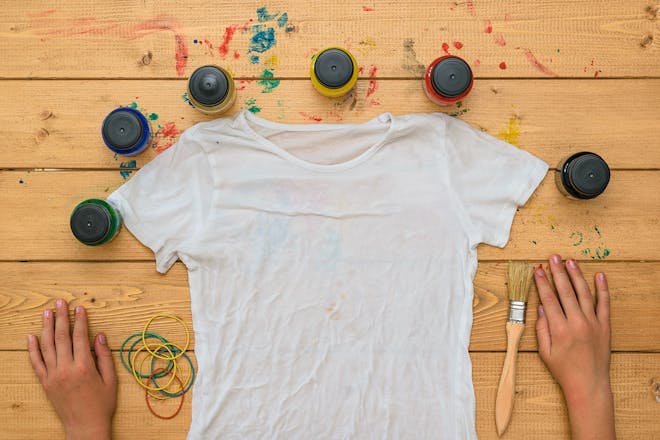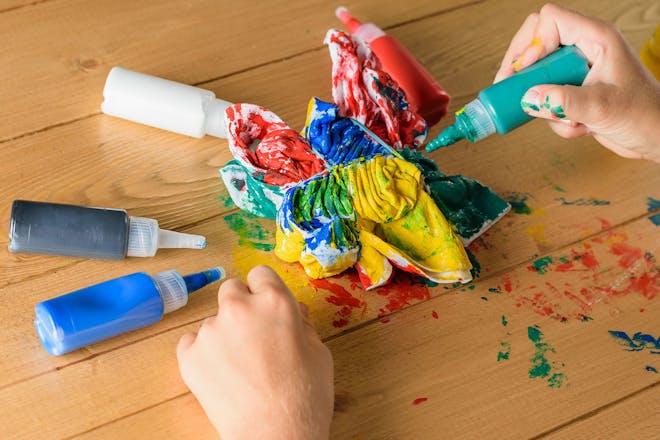How to tie dye: 3 simple techniques for kids

It's the coronavirus craft trend that's all over Instagram – and kids love it! Here's how to tie dye with children and get amazing effects.
This page contains affiliate links, which means we may earn a small amount of money if a reader clicks through and makes a purchase. All our articles and reviews are written independently by the Netmums editorial team.
Tie dye is a great way to get crafty with the kids. It's not as messy as it sounds (well, maybe a bit messy), it's loads of fun, and kids love wearing something they've helped make themselves.
With a bit of supervision, young children will enjoy adding colourful patterns to T-shirts, tea towels, tracksuit bottoms, socks or anything else they fancy. Older kids can be let loose on their own and come up with creative patterns using the simple techniques below.
Here's how to tie dye with kids.
What is tie dye?
Tie dye is a way of making colourful patterns on fabric. This is done by folding, tying or crumpling fabric, then applying dye. The dye won't be able to reach into the folded fabric so you'll get some fun effects.
The bonus is that every single item you tie dye is going to be different so the finished results are always a bit of a surprise.
What items can I tie dye?
You can tie dye pretty much any fabric but natural fibres like cotton work best as they absorb the dye well. Lighter colours will show the colours and effects best, so a plain white T-shirt is a good project to start with.
What do I need to tie dye?
You can buy tie-dye kits from most craft stores and retailers like Amazon. These are really easy to use as they contain everything you need to start tie dying – they also offer a selection of different coloured dyes.
We like this kit that has 12 bottles of dye, plus protective gloves and instructions. See more details here at Amazon.
If want to tie dye without a kit you'll need:
- Rubber gloves
- Rubber bands
- Fabric dye – put this in old spray or squeezy bottles, or use a paint brush to help you apply it
- Water to mix your dye
Where should I tie dye?
You can tie dye anywhere but make sure you protect any surfaces from the dye first. If you have a garden, it's a good idea to tie dye outside on some plastic sheeting or an old towel incase the kids get a bit carried away.
It's also best to wear old clothes or an apron when you're tie dying.

How do I tie dye?
Now you've got everything you need together it's time to get crafty. For a simple tie dye, just follow the easy instructions below. We've presumed you're dying a T-shirt but the same steps will work for nearly all items.
Once you've got the basics nailed, scroll down to discover three easy techniques that give really professional effects.
Step-by-step tie dye instructions
1. Read the instructions on your dye, some require you to wet the T-shirt you're using first to help absorb the dye.
2. Scrunch up your T-shirt.
3. Place rubber bands around the T-shirt to hold it in place.
4. Apply dye to the scrunched up T-shirt. Using different colours in different sections will give a multicoloured effect. Remember that the dye will bleed, so if you don't want colours to blend together, leave a bit of a gap between each one.

5. Let your T-shirt absorb the dye. The longer you leave it, the deeper the colour. Developing times will vary with different dyes so check the instructions. As a general rule, one or two hours will give you a pastel effect, while six hours upwards will give you a more vibrant pattern
6. To prevent your T-shirt getting dye on any surfaces while it develops, wrap it in clingfilm or put it in a ziploc bag.
7. Once you've left your T-shirt for a few hours, remove the elastic bands and rinse it in cold water until the water runs clear.
8. Now put your T-shirt in the washing machine. Once it's dry, it's ready to wear!

3 easy tie dye techniques for kids
If you want to try your hand at some cool effects, these three simple techniques are really easy to do and fun for older kids to try. And the beauty of tie dye is that you can't go wrong. Whatever you do, you're going to get an interesting new effect so get experimental and see what happens.
1. How to create a spiral effect in tie dye
Looking to create a spiral pattern on your tie dye T-shirt? Here's how.
- Pick a point in the centre of your T-shirt between the armpits.
- Hold your thumb down on the spot or use a stick (a wooden spoon works) and twist the fabric around clockwise so it looks a bit like a snail's shell.
- Fasten the spiral in shape with rubber bands and apply your dye.
2. How to make stripes in tie dye
This subtle striped effect is really easy to achieve.
- Fold in the sleeves and then start folding your T-shirt in a concertina pattern, like you're making a fan. You should be left with a long strip of fabric.
- Place rubber bands where you want the white stripes to be and then dye.
- You can dye each section a different colour or just use one or two colours, it's up to you.
3. How to make a bullseye shape in tie dye
A classic tie dye effect, the bullseye is so much easier than you'd think.
- Pinch the centre of your T-shirt and pull it up. A bit like you're creating a fabric ghost.
- Apply a rubber band around the middle of this pulled up piece of fabric.
- Carry on applying rubber bands further down the fabric to create a bullseye effect and then add your dye.
Have you been tie dying with the kids? Share your favourite at-home activities with other parents in the forum below.
Related stories
24 easy recycled craft ideas for kids
CHAT: activities to do at home
100 activities if you're stuck indoors with kids
This article contains affiliate links, which means we may earn a small amount of money if a reader clicks through and makes a purchase. All our articles and reviews are written independently by the Netmums editorial team.


